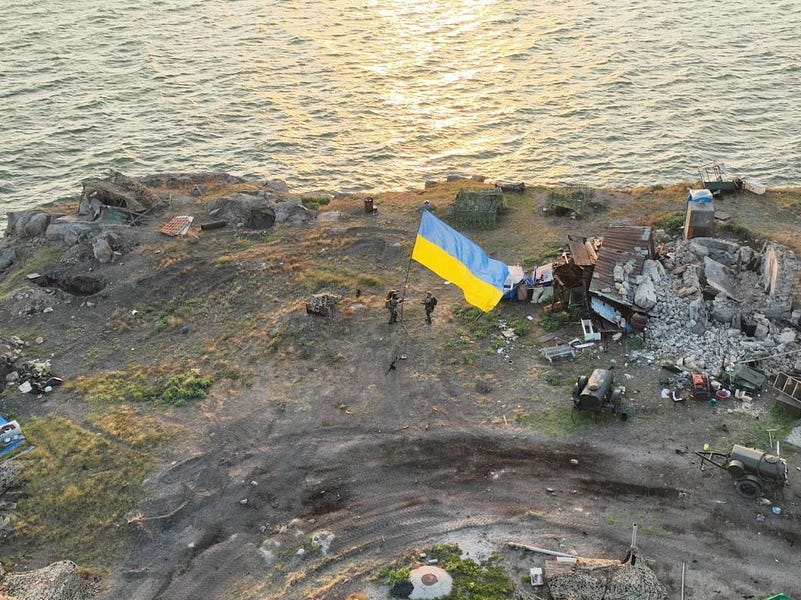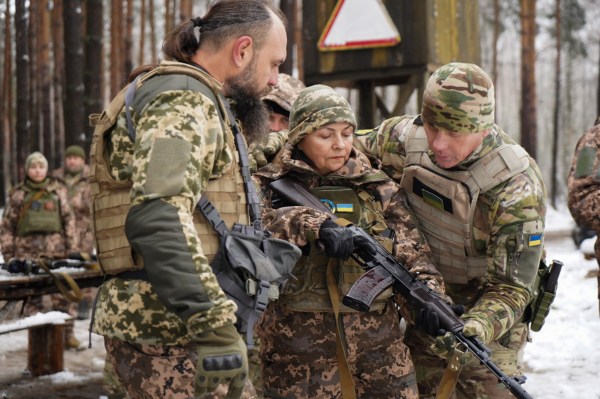Last summer in Kyiv, I wrote an editorial for the Ukraine Business News titled: “Would NATO Fight for Snake Island?”
With Ukraine’s flag rising last week over this strategic Black Sea island near the mouth of the Danube, the answer is: NATO weapons, yes; NATO soldiers, no.
Ukraine’s constitution states that joining NATO is a national goal. But admitting Ukraine is not supported by all NATO’s member countries, soon to be 32 with the upcoming addition of Finland and Sweden. NATO’s rules require candidate countries to settle their border disputes with their neighbors. Ukraine is unlikely to achieve this as long as Vladimir Putin remains in the Kremlin.
In the face of Russia’s war against Ukraine, NATO leaders agreed at the recent summit in Madrid to sharply increase the number of forces NATO keeps at a high readiness level—from 40,000 to 300,000. But that may be more aspiration than reality anytime soon. No NATO boots are expected on the ground in Ukraine.
Nevertheless, an amazing amount of NATO weaponry, largely from the U.S., is coming to Ukraine’s troops in southeastern Ukraine.
On July 5, the Pentagon posted a comprehensive list of the U.S. military aid. Highlights include 1,400 Stinger anti-aircraft systems, 6,500 Javelin anti-armor systems, 700 Switchblade tactical unmanned aerial systems; 126 155mm Howitzers and 126 tactical vehicles to tow them, up to 410,000 155mm artillery rounds, 36,000 105mm artillery rounds, hundreds of armored high-mobility multipurpose wheeled vehicles, 200 M113 armored personnel carriers, more than 10,000 grenade launchers and small arms, more than 59,000,000 rounds of small arms ammunition, and eight HIMARS (high mobility artillery rocket systems) and ammunition.*
After weeks of setbacks for Ukraine, this cornucopia of modern U.S. arms may start to turn the tide of war.
A sign of the future may have come with Russia’s hasty abandonment of Snake Island.
For 2,000 years, this 46-acre rocky island has held a strategic position in the Black Sea. The ancient Greeks raised a temple there to Achilles, the Trojan War hero celebrated in Homer’s Iliad. In more modern times, it was bombed by the Turks in World War I and by the Soviets in World War II. Then, it was transferred from Romania to the Soviet Union and, finally, to Ukraine.
Last August, I wrote: “By seizing Snake Island, Russia could create a 200 km (125 mile) east-west line, controlling shipping in and out of all of Ukraine’s Black Sea ports.”
Seven months later, Russia did exactly that. On February 24, the first day of the war, two Russian warships approached the island and ordered the small Ukrainian detachment of border guards to surrender. A Ukrainian soldier responded with the now epic phrase: “Russian warship: go f–k yourself.” Ultimately, the Ukrainians surrendered.
The soldier’s response went viral, prompting Ukraine’s postal service to issue a stamp depicting him raising a middle finger salute to the Moskva, the Black Sea flagship of Russia’s navy. Coincidentally, two days after the stamp came out, Ukrainian missiles sank the Moskva.
For four months, the Russians heavily reinforced their detachment on the island. Installations included Tor and Pantsir air and missile defense systems, the kind featured in Red Square parades in Moscow.**
But Ukrainian aircraft and cruise missile attacks did not stop. Finally, during the night of June 30, the Russians evacuated the island in two speed boats. Seeking to save face, Russia’s Defense Ministry called it a “goodwill gesture” to restore grain exports from Ukraine. On Tuesday, Ukraine’s Infrastructure Ministry announced that the liberation of Snake Island had allowed 16 ships loaded with Ukrainian grain to enter the Danube through Romania’s Sulina Channel. Another 90 ships are awaiting their turn at the Romanian mouth of the Danube.
Last week, Ukraine’s military released drone photos of Ukraine’s blue and gold flag waving again over the island. Andriy Yermak, the Ukraine’s presidential chief of staff, posted on Telegram: “The flag of Ukraine is on Snake Island. Ahead of us are many more such videos from Ukrainian cities that are currently under temporary occupation.”
Within hours, a Russian war jet bombed the island once again.
Rob Lee of the Philadelphia-based Foreign Policy Research Institute told Reuters last week that abandonment of the island was “likely a tangible result of NATO arms deliveries to Ukraine.”
He said that new NATO-supplied weapons made the Russian garrison even more vulnerable. On June 17, Ukraine’s Defense Ministry said it had used a U.S.-made Harpoon missile to sink a Russian tugboat attempting to supply Snake Island. On Monday, Serhiy Bratchuk, spokesman for Odesa’s Regional Administration said a bombing by a U.S.-supplied HIMARS system killed one Russian major general and 12 officers.
While Ukraine benefits from an influx of U.S., U.K., and EU weaponry, Russia is running low on certain types of weaponry. In recent days, Russian missiles hit a Black Sea resort apartment building and a shopping center in central Ukraine. In both cases, the Russians used anti-ship missiles that are inaccurate when fired at land targets, showing the strain on Russian precision-guided munition stockpiles, as well as a callous disregard for the civilian casualties that would likely result from such a crude strike.* Similarly, the Russian Army is pulling out of storage T-62 tanks—a battle tank first introduced in 1961.
Estimates of deaths of Russian military personnel range from 25,000 by Britain’s Defense Ministry to 37,470 by Ukraine’s Defense Ministry.
To reduce political pressure, the Kremlin is leaning heavily on non-ethnic Russians—Bashkirs, Chechens, Dagestanis, and Tuvins—to help fight the war. Mediazona, an independent Russian news site, tallies only eight dead soldiers from Moscow and 26 from St. Petersburg.
Regardless, during almost five months of war against Ukraine, Russian losses of manpower and equipment exceed those suffered by the Soviet Union during its decade-long occupation of Afghanistan in the 1980s.
The war is expected to grind into the winter. But, in the coming weeks, Ukraine’s counteroffensives may start to turn the tide. Russians have a superstition that August brings bad news. Think August 1914.
*Corrections, July 15: This article originally misstated the number of Howitzers provided to Ukraine and also misidentified the air defense systems Russia was using on Snake Island.
*Corrections, July 18: This article also misidentified the anti-ship missiles used by Russia in recent attacks and misstated Russian totals of lost war materiel.
James Brooke is a visiting fellow at the Foundation for Defense of Democracies. He has traveled to about 100 countries reporting for the New York Times, Bloomberg and Voice of America.








Please note that we at The Dispatch hold ourselves, our work, and our commenters to a higher standard than other places on the internet. We welcome comments that foster genuine debate or discussion—including comments critical of us or our work—but responses that include ad hominem attacks on fellow Dispatch members or are intended to stoke fear and anger may be moderated.
You are currently using a limited time guest pass and do not have access to commenting. Consider subscribing to join the conversation.
With your membership, you only have the ability to comment on The Morning Dispatch articles. Consider upgrading to join the conversation everywhere.